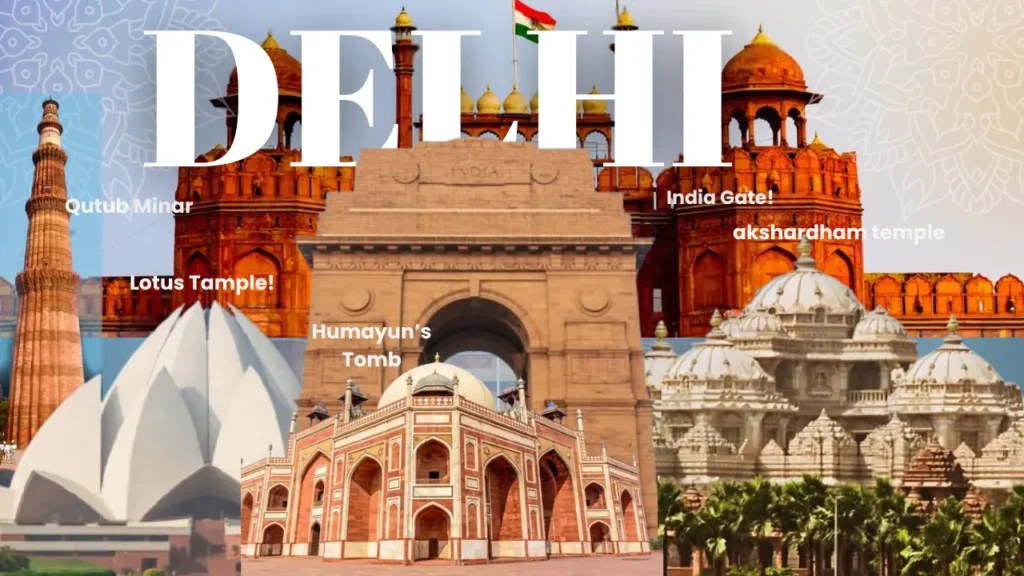
ISKON TEMPLE
The International Society for Krishna Consciousness (ISKCON), also known as the Hare Krishna movement, is a Gaudiya Vaishnava Hindu religious organization founded by A.C. Bhaktivedanta Swami Prabhupada on July 13, 1966, in New York City. With its headquarters in Mayapur, West Bengal, India, ISKCON has over 800 temples and centers worldwide, including prominent ones in Vrindavan, Delhi, and Bengaluru.
Key Features of ISKCON Temples
- Architecture: ISKCON temples showcase stunning Hindu temple architecture, with intricate designs and ornate structures. For example, the ISKCON Temple in Vrindavan, built in 1975, is situated on the banks of the Yamuna River, where Krishna and Balarama are said to have herded cows.
- Deities: The temples are dedicated to Radha Krishna, Krishna Balaram, and other deities, with intricate carvings and gold-plated features, such as the gold-plated flag post and kalash shikhara at the ISKCON Temple Bengaluru.
- Festivals: ISKCON temples celebrate various Hindu festivals, including Janmashtami, Radhashtami, Gaura Purnima, and Ratha Yatra, which feature devotional singing, dancing, and feasting.
Notable ISKCON Temples in India
- ISKCON Vrindavan: Located in the Raman Reti area, this temple is built on the site where Krishna and Balarama are believed to have lived.
- ISKCON Delhi: Situated in East of Kailash, this temple complex features the Glory of India Vedic Cultural Centre, with interactive exhibits on Hindu texts and the world’s largest printed Bhagavad Gita.
- ISKCON Bengaluru: This temple, inaugurated in 1997, features six shrines, including Radha Krishna and Krishna Balaram, and offers free food to those in need through the Akshaya Patra Foundation.
ISKCON’s Philosophy and Practices
- Gaudiya Vaishnavism: ISKCON follows the teachings of Chaitanya Mahaprabhu, emphasizing devotion to Krishna through chanting, singing, and service.
- Spiritual Practices: Devotees engage in daily ceremonies, such as mangala-arati, japa meditation, and kirtan, to deepen their connection with Krishna.
- Community Service: ISKCON temples often provide food, education, and healthcare to local communities, promoting spiritual growth and social welfare.¹ ² ³
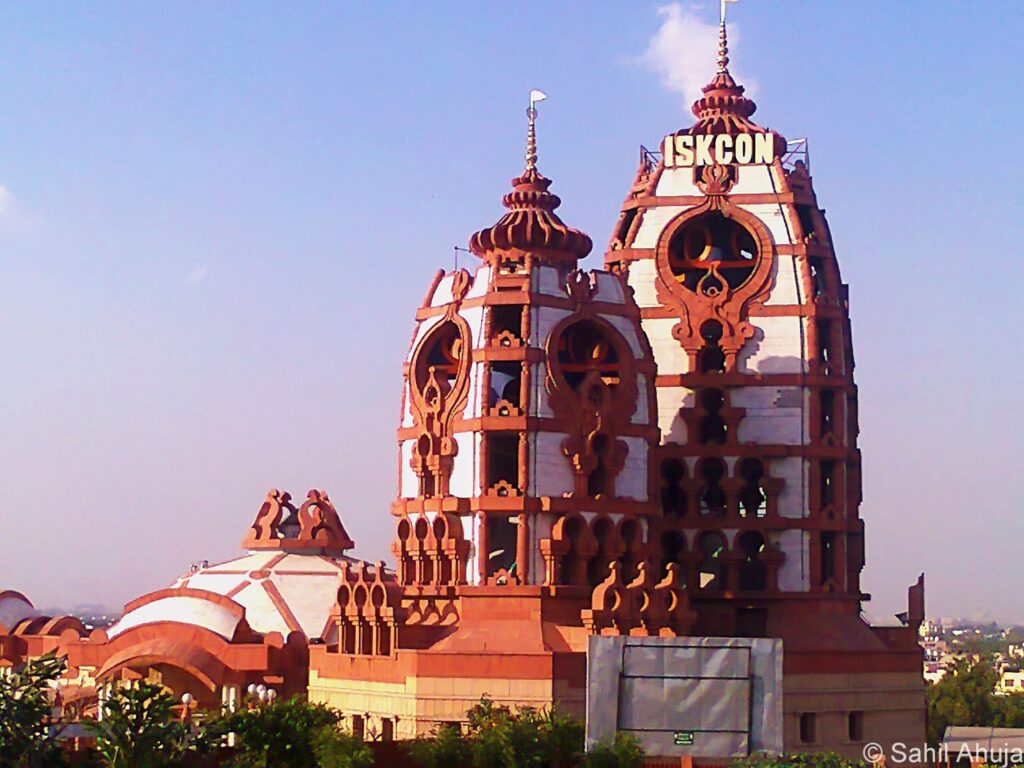
INDIA GATE
India Gate is a war memorial located in New Delhi, India, on Rajpath, formerly known as Kingsway. Designed by Sir Edwin Lutyens, it was built to commemorate the 74,187 soldiers of the Indian Army who died between 1914 and 1921 in World War I and the Third Anglo-Afghan War. The gate stands 42 meters tall and is made of red Bharatpur stone and granite. It features intricate designs, including sunburst motifs and a shallow domed bowl at the top.
History
- Foundation Stone: Laid on February 10, 1921, by the Duke of Connaught
- Inauguration: On February 12, 1931, by Lord Irwin
- Original Purpose: To honor the soldiers who died in World War I and the Third Anglo-Afghan War
Key Features
- Architecture: Inspired by ancient Roman triumphal arches, such as the Arch of Constantine
- Inscriptions: “To the dead of the Indian Armies who fell and are honoured in France and Flanders, Mesopotamia and Persia, East Africa, Gallipoli and elsewhere in the Near and Far East”
- Names: 13,313 servicemen’s names are engraved on the gate
Significance
- National War Memorial: India Gate serves as a symbol of India’s military history and sacrifice
- Republic Day Celebrations: The Prime Minister visits the gate to pay tributes to the Amar Jawan Jyoti, the flame of the immortal soldier
- Tourist Attraction: India Gate is a popular destination for both Indians and foreigners
Amar Jawan Jyoti
- Established: On January 26, 1972, to commemorate the soldiers who died in the Bangladesh Liberation War
- Significance: Serves as India’s tomb of the unknown soldier, symbolizing the nation’s gratitude to its martyrs¹
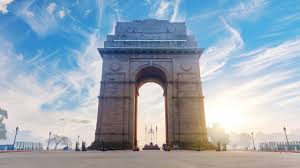
QUTUB MINAR
Qutub Minar is a towering minaret and victory tower located in the Qutb complex in South Delhi, India. It’s a UNESCO World Heritage Site and stands at an impressive 72.5 meters tall, making it the tallest minaret in the world built of bricks. The construction began in 1199 under Qutb-ud-din Aibak, a deputy of Muhammad of Ghor, after he defeated Prithviraj Chauhan, the last Hindu ruler of Delhi. However, Aibak only managed to complete the first level before his death.
History and Construction
- Initiation: Qutb-ud-din Aibak started building Qutub Minar as a symbol of victory and to mark the beginning of Islamic rule in India.
- Completion: The minaret was completed by Aibak’s son-in-law, Shamsuddin Iltutmish, who added three more stories.
- Renovation: In 1368, Firuz Shah Tughlaq rebuilt the top parts and added two more stories after the original structure was damaged by lightning.
Architectural Significance
- Inspiration: Qutub Minar’s design was inspired by the Minaret of Jam in Afghanistan.
- Unique Blend: The minaret showcases a blend of Indo-Islamic and Afghan architectural styles, reflecting the cultural diversity of India.
- Materials: The tower is built using red sandstone and marble, with intricate carvings and inscriptions from the Quran.¹ ²
Features and Facts
- Height: Qutub Minar stands at 72.5 meters, with a base diameter of 14.32 meters and a top diameter of 2.75 meters.
- Steps: The minaret has 379 spiral steps.
- Iron Pillar: The complex includes an ancient iron pillar that has resisted rusting for centuries.
- Quwwat-ul-Islam Mosque: The mosque, built near Qutub Minar, is one of the oldest in India and features reused materials from 27 Jain and Hindu temples.³
Cultural Significance
- Tourist Attraction: Qutub Minar is a popular tourist destination, attracting thousands of visitors each year.
- Symbolism: The minaret symbolizes India’s rich cultural heritage and the blending of different architectural styles.
- UNESCO Heritage Site: Qutub Minar was designated a UNESCO World Heritage Site in 1993, recognizing its cultural and historical significance.⁴
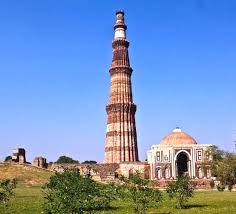
RED FORT DELHI
The Red Fort, also known as Lal Qila, is a historic Mughal fort in Delhi, India, that served as the primary residence of the Mughal emperors. Emperor Shah Jahan commissioned its construction on May 12, 1639, and it was completed on April 6, 1648. The fort is a masterpiece of Mughal architecture, blending Persian palace influences with indigenous Indian traditions.
Key Features
- Architecture: The Red Fort’s design is attributed to Ustad Ahmad Lahori, the architect behind the Taj Mahal. It showcases a high level of ornamentation, with marble and floral decorations exemplifying later Mughal architecture.
- Structure: The fort spans 254.67 acres, enclosed by 2.41 kilometers of defensive walls, which vary in height from 18 meters to 33 meters.
- Gates: The fort has two main public gates, the Lahori Gate and the Delhi Gate, with the Lahori Gate serving as the main entrance.
- Palaces and Gardens: The fort complex includes several notable structures, such as the Diwan-i-Aam (Public Audience Hall), Diwan-i-Khas (Private Audience Hall), Mumtaz Mahal, Rang Mahal, Khas Mahal, and the Hayat Bakhsh Bagh (Life-Bestowing Garden).
History
- Mughal Era: The Red Fort was the centerpiece of Shahjahanabad, the city now known as Old Delhi. It was plundered and stripped of its artwork and jewels during Nadir Shah’s invasion in 1739.
- British Era: The fort was used as a garrison by the British, who demolished many of its structures after the Indian Rebellion of 1857.
- Independence: On August 15, 1947, the first Prime Minister of India, Jawaharlal Nehru, raised the Indian national flag above the Lahori Gate.
Significance
- UNESCO Heritage Site: The Red Fort was recognized as a UNESCO World Heritage Site in 2007.
- National Importance: The fort is a monument of national significance, and each year on India’s Independence Day, the Prime Minister hoists the national flag and delivers a speech from its ramparts.¹.
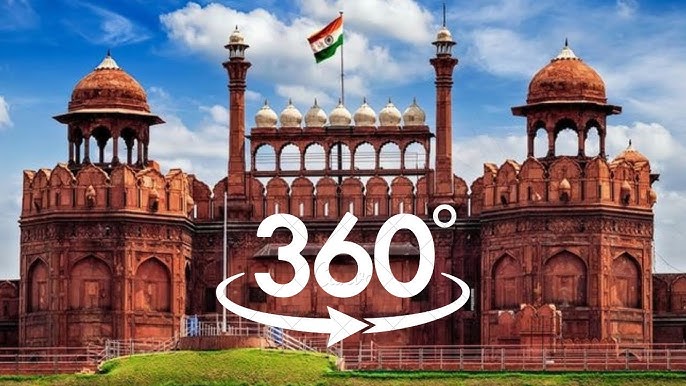
LOTUS TEMPLE
The Lotus Temple, located in New Delhi, India, is a Bahá’í House of Worship that was completed in December 1986. Designed by architect Fariborz Sahba, the temple’s striking lotus flower-inspired design has made it a prominent landmark in the city. The temple’s structure consists of 27 marble-clad petals arranged in clusters of three, forming nine sides. These petals are free-standing and can accommodate up to 2,500 people.
Key Features of the Lotus Temple
- Architecture: The temple’s design is inspired by the lotus flower, symbolizing purity, peace, and unity.
- Materials: The temple is made of white Pentelic marble, with a glazed surface to reflect sunlight.
- Environmental Features: The temple’s design incorporates natural ventilation, reducing the need for air conditioning.
- Spiritual Significance: The temple serves as a place of worship for people of all faiths, emphasizing the unity of all religions.
History and Construction
- Design and Planning: The temple’s design was inspired by the lotus flower and was planned to reflect the principles of the Bahá’í Faith.
- Construction: The temple took six years to complete, with construction beginning in 1980.
- Inauguration: The temple was inaugurated on December 24, 1986.
Visitor Information
- Location: The Lotus Temple is located in Sector 29, Bahapur, New Delhi.
- Timings: The temple is open from 9:00 AM to 6:30 PM, with an information center and library available for visitors.
- Accessibility: The temple is wheelchair accessible and offers facilities for visitors with disabilities.
The Lotus Temple has become a popular tourist destination and a symbol of spiritual unity, attracting millions of visitors each year. Its unique design and peaceful atmosphere make it a place for reflection and contemplation.
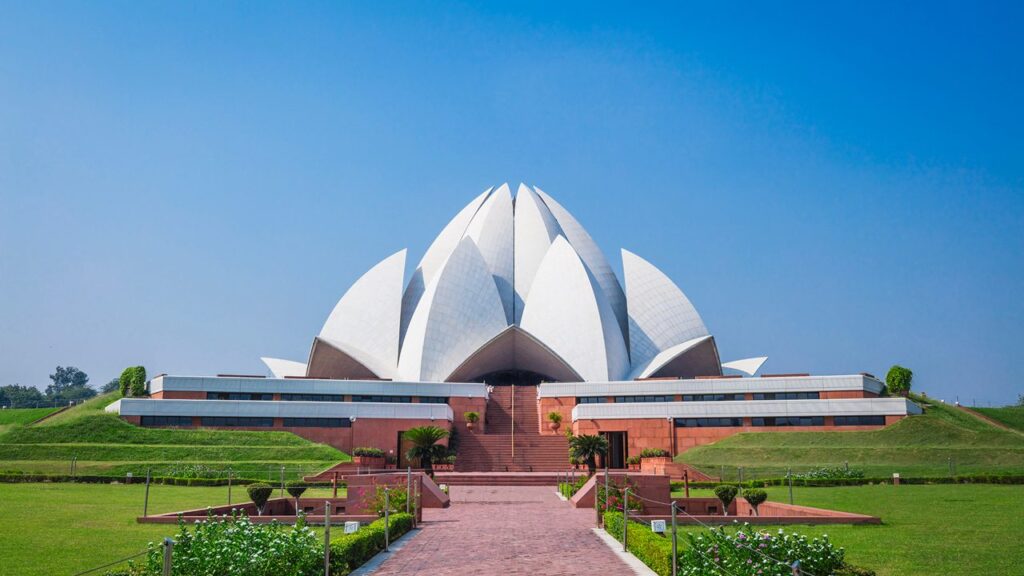
The Lotus Temple is a Baha’i House of Worship in New Delhi, India, known for its distinctive lotus-flower-inspired design. India Gate is a war memorial in Delhi, commemorating Indian soldiers. Lal Qila (Red Fort) is a historic Mughal fort in Old Delhi, serving as the main residence of Mughal emperors. Qutub Minar is a UNESCO World Heritage Site, a towering minaret in Delhi, the tallest brick minaret in the world.

Lotus Temple: This temple is a Baháʼí House of Worship designed by Fariborz Sahba and completed in 1986. Its shape is inspired by the lotus flower, symbolizing purity and the universality of the Baháʼí Faith. The temple has 27 free-standing marble-clad “petals” arranged in clusters.
India Gate: This war memorial, located on Rajpath, stands as a tribute to Indian soldiers who died in World War I and other conflicts. It’s a prominent landmark in Delhi.

Lal Qila (Red Fort): Built by Emperor Shah Jahan in the mid-17th century, the Red Fort served as the main residence of the Mughal emperors. It’s a UNESCO World Heritage site and a major tourist attraction.
Qutub Minar: This UNESCO World Heritage Site is a towering minaret in Delhi, made of red sandstone and marble. It’s the tallest brick minaret in the world, standing at 72.5 meters tall. The construction was started by Qutb ud Din Aibak in 1192.
